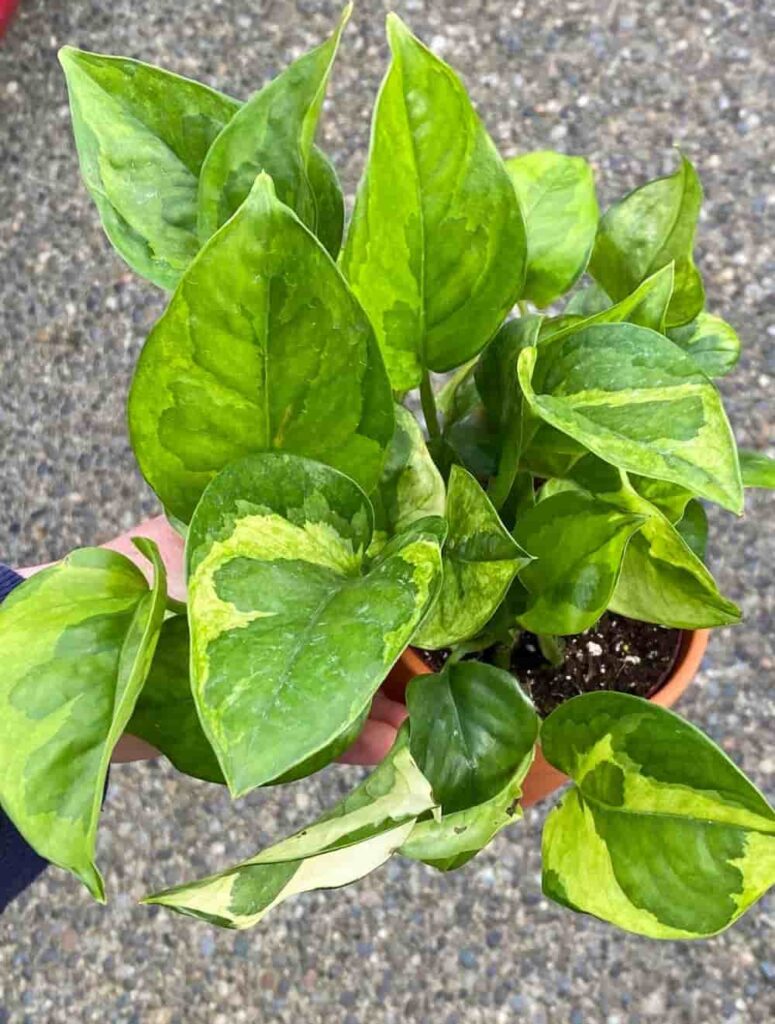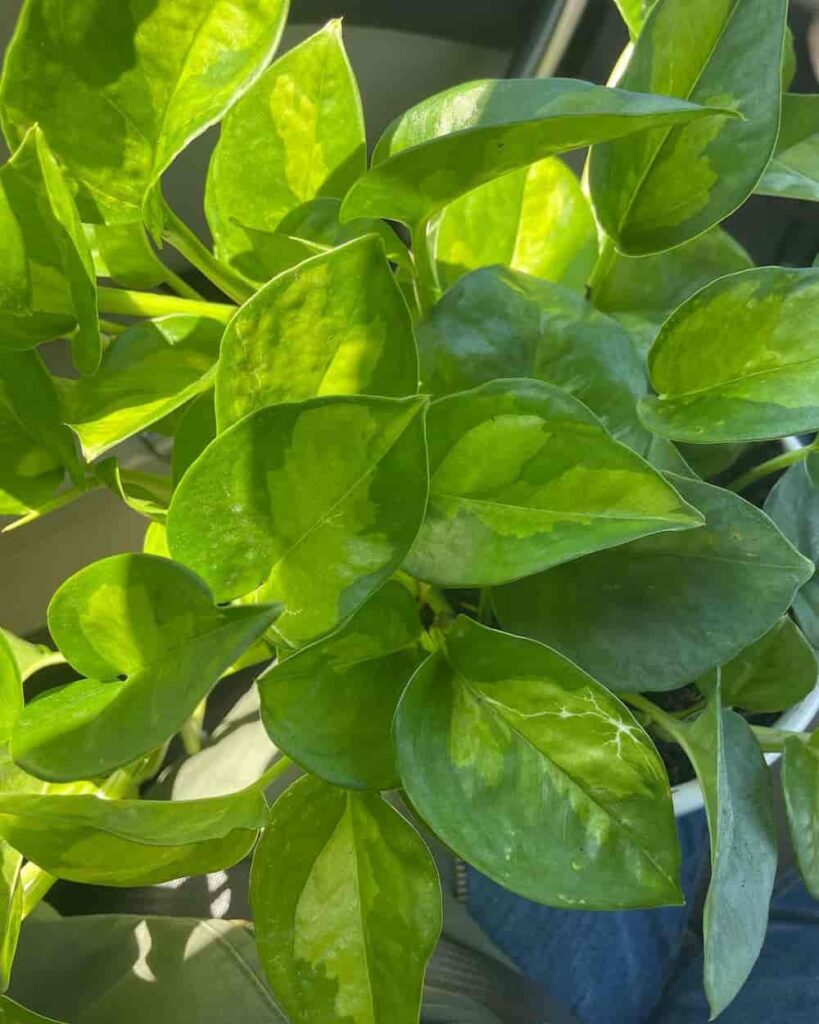The Emerald pothos is a stunner like no other, beloved by houseplant enthusiasts for its enigmatic variegation and bright, glossy green leaves. Originating in the Solomon Islands, the Emerald pothos is a tropical plant and is, for this reason, relatively unfussy in its care requirements. However, it is still considered rare in that you won’t easily find it in your local nursery or garden center.
Should you be lucky enough to get your hands on one, you won’t be disappointed. While the Emerald looks similar to other plants in the pothos genus, it has one striking characteristic that sets it apart from the rest. This is, of course, its unique variegation – a mix of light and dark green patterns that give the impression that its leaves have been dipped in watercolors.
In this article, we’ll take a deep dive into everything you need to know about the Emerald pothos, from its care requirements to where to find one and how much you can expect to pay. Ready? Let’s investigate.

Table of Contents
What is the Emerald pothos?
The Emerald pothos is a unique and much-loved houseplant characterized by plentiful heart-shaped leaves that comprise elegant light and dark green variegation. It is easy to care for and propagate, making it a popular choice for the home, growing at a medium to fast rate.
Like most types of plants in the pothos family, the Emerald is an absolute joy to have in the home. Going by the botanical title of Epipremnum aureum “Emerald,” this beauty is, technically, a cultivar of the pothos N’Joy variety, which are smaller and denser than run-of-the-mill pothos. Even so, it can still trail up to 10 feet (3 meters) in ideal growing conditions.
It’s for this reason that, usually, Emerald pothos are kept in hanging baskets which emphasize their beautiful trailing growth patterns.
Epipremnum varieties, like Monstera and philodendrons, are popular for their easy-going natures. They share similarities with other species in the Araceae family, like the fact that they have both terrestrial and aerial roots and are accustomed to growing in bright but indirect light. Their aerial roots account for the fact that they can either hang or climb, depending on where they are situated.
You may also be interested in: Can You Plant Pothos and Philodendron Together?
In terms of their variegation, Emerald pothos have unique patterning that is darker toward the center vein and lighter toward the edges. However, their markings are sporadic, making each leaf look distinctive in its own right. It is this patterning that makes the Emerald so sought-after, even though these plants are often confused with other pothos varieties.
In what follows, we’ll look at how to tell the Emerald apart from the Global Green pothos and the Jade pothos.
Are Emerald pothos and Global Green pothos the same?
No, the Emerald pothos and the Global Green pothos are not the same plant. The main difference is in the coloring of their leaves, with the Emerald having leaves with a dark green center and lighter edges, whereas the Global Green has light centers and dark edges. In short, they are the inverse of one another.
It’s true that they are often mistaken for one another, given that they share the same signature heart-shaped leaves and trailing growth habits.
However, in terms of patterning, the Global Green pothos also has more dramatic variegation than the Emerald’s more fluid coloring. But alas, this is where their differences end – their care requirements are identical.

Jade vs Emerald pothos
The main difference between the Jade pothos and the Emerald pothos is their variegation. The Jade pothos, an equally stunning plant, has bright green leaves peppered with white and cream splatters and speckles, whereas the Emerald has dark and light green patterns. Occasionally, the Jade may even appear to have gray coloring.
Variegation aside, the Jade and Emerald share many similar characteristics. They are both N’Joy cultivars that are popular as houseplants and delightful to look after. They are also both fast-growing and can reach up to 10 feet (3 meters) in length.
Emerald pothos care
The Emerald pothos is a low-maintenance plant with simple care requirements. It enjoys bright, indirect light, warm temperatures, high humidity, and moderate watering. In terms of soil, the Emerald pothos needs nutrient-rich soil but doesn’t necessarily require fertilization. It is not prone to pests and diseases (except root rot) and can easily propagate by division.
If you’re looking to add an Emerald pothos to your collection, you won’t be disappointed. This beauty is remarkably easy to care for, and with a good routine, it won’t require much of your time or fuss. Indeed, you’re pretty unlikely to knock your Emerald off the mortal coil once it gets going, provided you set up some good fundamentals from the get-go. Much of this depends on its growing environment.
In what follows, we’ll look at the Emerald pothos’s needs in detail.
1. How much light does an Emerald pothos need?
Provide your Emerald with bright but indirect light for 6 to 8 hours every day. Their variegation makes them slightly tricky in that they don’t photosynthesize as well as their fully-green cousins, but this is easily solved by placing them near a big window. Without sufficient light, they may lose some of their distinctive patternings.
A characteristic that many tropical plants share is their love of dappled light. The Emerald pothos is no different. This preference stems from their natural habitat, where they are accustomed to receiving sun filtered through the leaves of larger trees.
Indoors, your best bet to emulate this environment by following the amount of light mentioned above. My personal predilection is to keep my variegated pothos close to East or South-facing windows that attract softer morning light, as harsh rays can burn or scorch them. Outdoors, you’ll need to provide your Emerald pothos with some form of shading to prevent direct UV contact.
Find out more: What Are Your Pothos’ Light Needs (So Your Plant Can Thrive)?
2. Do Emerald pothos need warm temperatures?
While the Emerald pothos can tolerate a surprisingly wide range of temperatures, their preference is warmth, given their tropical beginnings. They can survive temperatures as low as 50F (10C), but they will struggle to thrive and may suffer stunted growth. Their ideal is a space with a consistent temperature of 70F to 80F (21C to 27C).
Together with this, Emerald pothos also don’t enjoy extreme temperature swings (think bright direct sunlight, harsh drafts, or air conditioners). Even if you can’t keep it warm all the time, try to place your Emerald in a consistent and sheltered space, where it can settle and adapt to its given environment.

3. How much humidity does an Emerald pothos need?
All plant species of a tropical persuasion enjoy high humidity because of the wet, moist environments they originate from. In a home environment, I always try to keep my pothos within a humidity range of 60% to 80%, even if I need to supplement it.
Generally, you can get away with daily sunlight and occasional misting, but if you notice your Emerald isn’t quite thriving, you may want to lend a hand with some additional moisture given how much pothos plants like humidity.
To add humidity to an Emerald pothos’s environment, consider investing in a small home humidifier. If this is not the route you wish to take, gathering your houseplants together can benefit them as they will give off moisture to one another. A third alternative is to set your pothos over a damp pebble tray.
4. How often should I water my Emerald pothos?
You can water your pothos every 7 to 10 days, but I always recommend instead feeling for when the top inch of its soil is dry before refreshing it. You should also taper off your watering regime in the cooler months of the year when your plants slow their growth. For safety’s sake, consider investing in a moisture meter.
The biggest problem most houseplant lovers face in their pothos is root rot, which is a risk even with this low-maintenance plant. Yes, that’s right – loving your plants to death is possible. This beauty is hardy, but you don’t want to overwater it, and you especially cannot leave it sitting in pooled water given how much pothos plants need drainage to thrive.
A good port of call is to go by judgment rather than routine. At the same time, underwatering your pothos can also be problematic and shouldn’t become a habit. Dry, yellow, or curled pothos leaves indicate that your plant is thirsty, and this type of damage can be irreversible over time.

5. What type of soil does an Emerald pothos need?
Like most aroid plants, the Emerald pothos does best with a well-draining, nutrient-rich soil that is relatively moisture-retentive. You can buy special pothos blends at your local garden center or mix your own by combining a good-quality potting soil with peat and perlite.
I also like to add a bit of orchid bark to my soil mix to ensure good airflow and prevent the soil from becoming too dense. If you’re concerned about pH levels in your pothos’ soil (pothos like neutral acidity), add in a few measures of activated charcoal.
6. Do I need to fertilize my Emerald pothos?
Fertilizing an Emerald pothos isn’t strictly necessary. Because they are so easy-going, they generally survive just fine on the nutrients they draw from their soil and energy from the sun. However, if you feel your Emerald pothos needs a bit of a boost, you can give it a dose of slow-release liquid fertilizer once or twice a year.
That being said, starting off slow with a lower dosage than recommended is always advisable. This will allow your Emerald a chance to adjust and should be sufficient for you to know if the fertilizer is beneficial or harmful.
7. Do I need to give my Emerald pothos a climbing pole?
Emerald pothos are equally beautiful whether you let them climb or trail. Because of their aerial roots, they’re adept at both, although, in their natural habitats, they’re more inclined to climb larger plants. If you want to give your Emerald a climbing pole, try a moss or coco coir pole that also provides it with nutrients.
Failing this, a trellis or mesh wire pole works just as well. Either way, to train your Emerald pothos to climb, you may need to lend a helping hand by gently attaching its petioles (connecting stems) to the pole with florist’s tape or twine.
Once it has settled, you can remove the tape and watch your Emerald thrive. Their natural tendency is to grow toward the light, so rotate your plant weekly.
Related: How to Put a Pothos on a Moss Pole (So It Thrives)
8. Do I need to prune (and propagate) my Emerald pothos?
Pruning houseplants is a necessary part of their upkeep, as it keeps them neat and healthy. Old and wilting leaves use energy that is better spent on new growth. Generally, I give my pothos a once-over as seasons change after the winter and summer.
Propagating pothos, in turn, is also healthy. Not only does it help you contain unruly growth, but you also end up with new plant babies that you can grow or sell. Emerald pothos propagates super well from stem cuttings, rooted in water, or directly into prepared soil.

Are Emerald pothos rare?
For decades, the Emerald pothos has been considered among the rarest of the pothos varieties. But, with increasing globalization and the upswing in popularity of houseplants at large, this is slowly changing. Today, it isn’t hard to find an Emerald pothos online or at a specialist nursery. However, you’re still unlikely to stumble across one in your local nursery.
If the enigmatic Emerald pothos is your heart’s desire, never fear. These enigmatic plants are no longer difficult to find, although you may still end up having to order one online. When doing so, also make sure to verify that the plant you are buying is indeed an Emerald and not a Global Green, as these two cultivars are often marketed interchangeably.
Where to find an Emerald pothos for sale?
Emerald pothos plants are most often sold online on sites like Etsy or eBay or from specialist breeders, although it’s always possible that you may find one at your local garden center. If you’re fortunate, you may be able to convince an Emerald owner to part with a cutting to propagate.
When I’m looking to track down a rare plant, I always start by browsing plant forums to determine the best place to purchase from.
What is a standard Emerald pothos price?
The demand for these rare beauties means they usually come at a slightly higher price tag than regular pothos. For a healthy cutting, you can expect to pay anywhere from $30 to $80. For a fully-fledged plant, you can pay $50 upwards.
